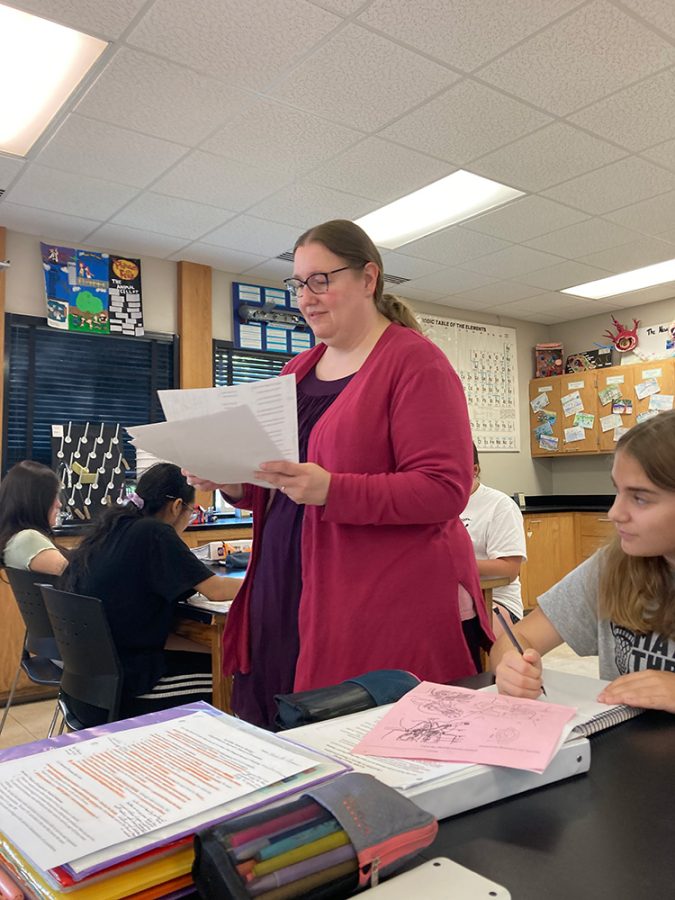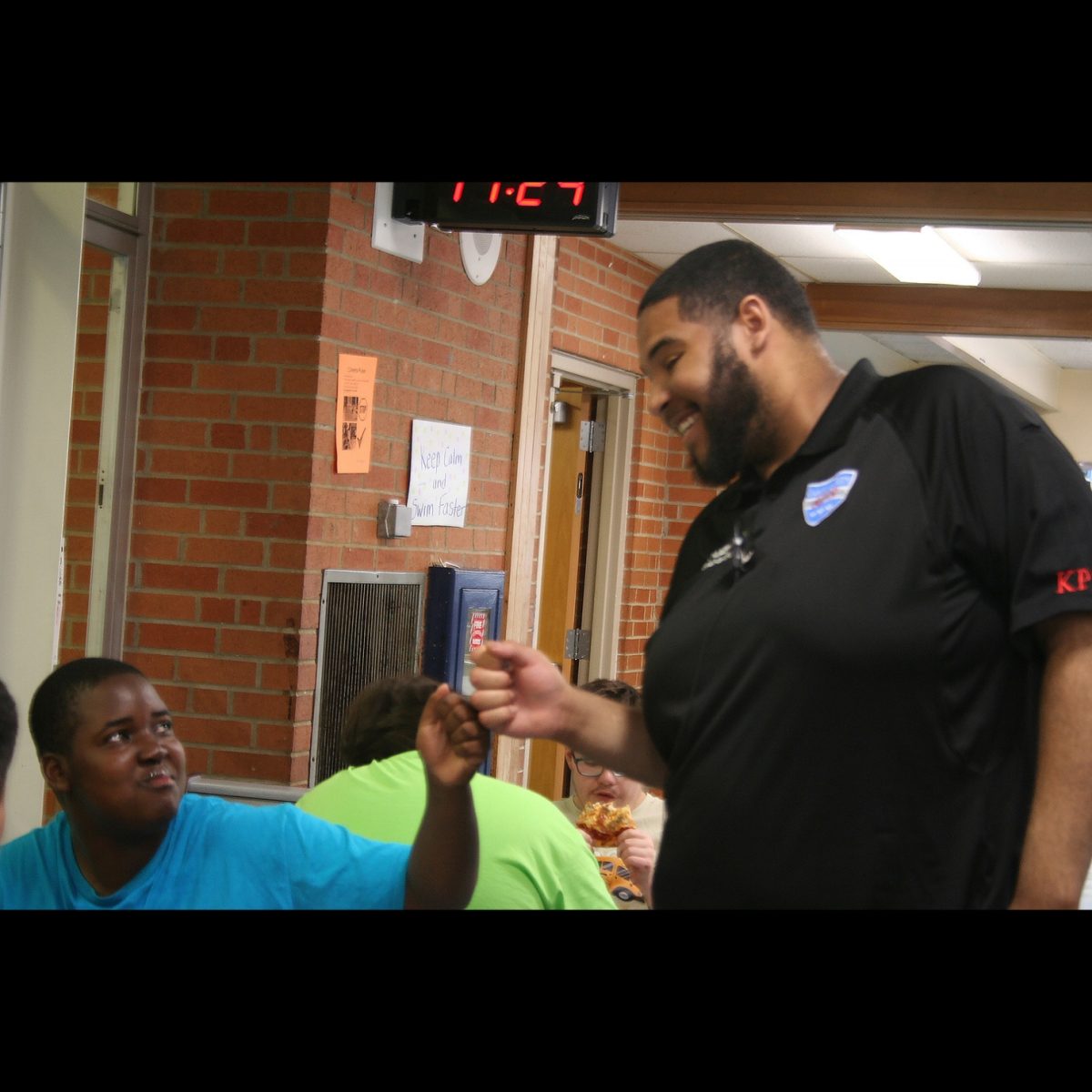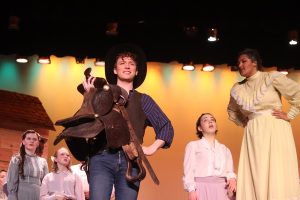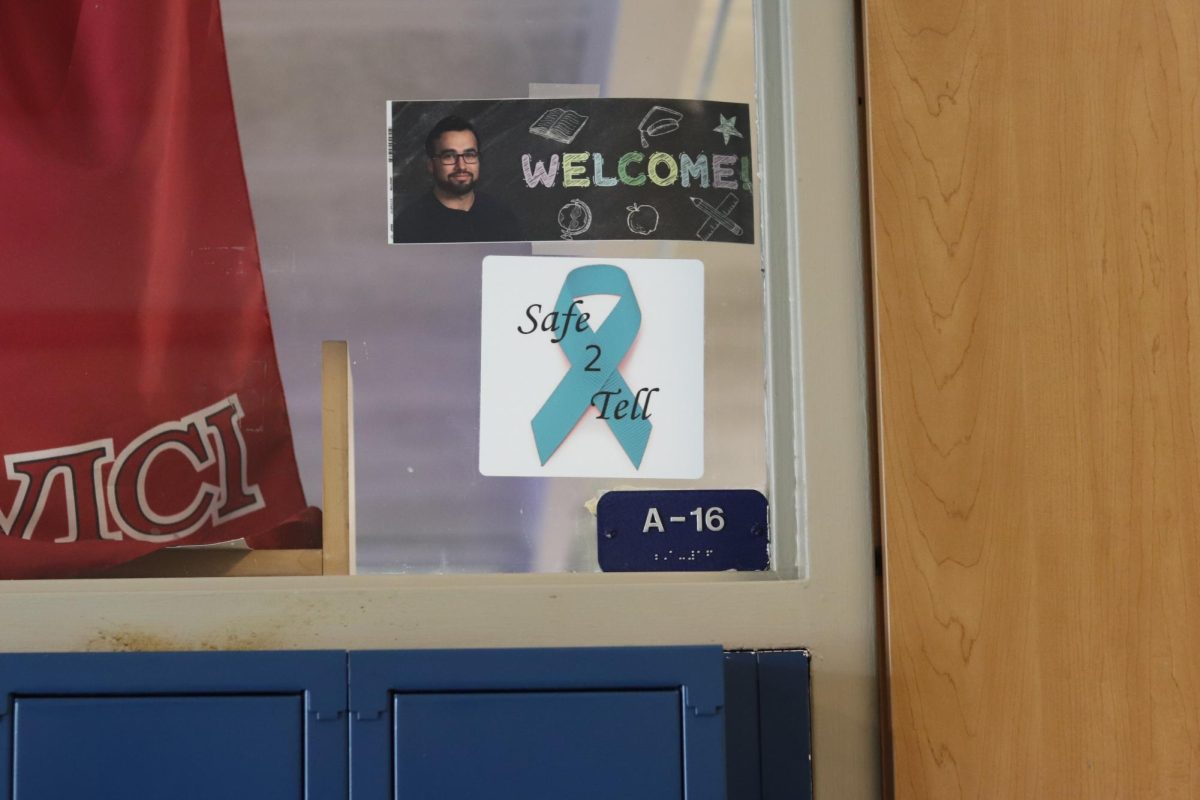KAMSC versus Norrix: teachers share similar attitudes towards students regardless of school setting
Credit: Alaina Suarez
KAMSC biology teacher Colleen Chapoton passes out old tests to her honors biology 9th grade students. They are reviewing their past assessments in preparation for final exams coming up in a week.
June 7, 2023
It’s a typical day at KAMSC: backpacks lay strewn messily against every wall, many students lounge next to them with legs sprawled out into the walkways while others meander through the halls peaking in and out of classrooms. Teachers grade last minute papers, attend to emails or answer student questions on homework assignments and tests.
Ten minutes away at Loy Norrix High School, bells ring and students head to classes chattering loudly. Kids and teachers settle down as announcements queue up and lessons follow.
The environment at the two schools is very different, but the perspectives of those who work at each location aren’t quite as contrasting.
Colleen Chapoton, known to many as simply “Chap,” has been the honors and AP biology teacher at the Kalamazoo Area Math and Science Center (KAMSC) for 8 years now. She has seen student excitement and engagement, cheating and lying and every in-between of teaching and working with students at a school like KAMSC.
KAMSC is an accelerated program for high school students of any grade level looking to be challenged in math, science, and computer science. According to the KAMSC website, the school accepts up to 300 total students from 13 feeder schools in the Kalamazoo area, all selected through an entrance process of exams and teacher recommendations.
Norrix, a public school of around 1,600 students, is a stark contrast to a school like KAMSC. It is a public school open to all who are in the district and even those beyond: no entrance exams or recommendation letters are required.
Jason Wagner has been a biology and AP biology teacher at Norrix for 18 years.
As for anything in life, Wagner comments that being a teacher at Norrix has its ups and downs. Being able to connect and form relationships with students is his favorite part of being a teacher. Though balancing those interactions with the right amount of content for each student can be difficult.
“The variety of ability levels and trying to get them all at the same place while challenging some and still making it interesting for others, that’s probably the challenging piece,” said Wagner.
Chap also believes that the students are what make the job for a teacher. And having interactions with her students, from a small smile to an email from a student ten years after graduating, are what makes her career meaningful.
“I love my students, first and foremost,” Chap said. “They are the light of my days. They are inquisitive, they are engaging, they’re interested, they make me laugh.”
On the other hand, lack of time is the hardest part of Chap’s job as a KAMSC teacher. She would love to be able to have more in-depth discussions with her students as well as have more time for grading and planning.
Many might think that student misbehavior would be the worst and toughest part of being a teacher anywhere. There are others that would assume that those who work at KAMSC and those who work at Norrix would have very different experiences in this regard.
That isn’t quite the case, neither Chap nor Wagner mentioned difficulties with student behavior or lack of attention as their primary concern when coming into school each day.
Wagner bases his teaching approach on relationships. Having strong connections with students allows him to avoid writing referrals or going down a disciplinary path when students act up. Typically, he has conversations with his students about their situations and tries to discover what he can do to help.
Chap also commented on having a similar conversational approach to dealing with student misbehavior, though that might be more because she doesn’t deal with very many issues with her students at KAMSC.
“As far as disciplinary issues,” Chap said, “I think once this year I had to tell a young student to not sit on the table.”
The biggest problems Chap has to deal with are in matters of student integrity. From her observations, a lot of KAMSC students are committed to being “perfect,” which causes many of them to refuse to ask for help with their schoolwork. This usually ends in cheating.
Having a relationship-based disciplinary system builds school communities.
As far as these communities go, diversity is a huge part of what these teachers love about their schools, though their definitions of diversity are slightly different.
Chap believes that KAMSC is more diverse in students than KPS schools like Loy Norrix. According to her, having students from all over Kalamazoo County creates a larger pool of experiences and backgrounds.
For teachers at KAMSC, this is special. Having the ability to watch students connect across their multi-school backgrounds is something that Loy Norrix teachers aren’t able to experience with their own students.
At Norrix, Wagner finds the diversity of students and teachers to be one of the best and most unique things about this school.
“Norrix does a good job of including diversity in the classroom,” Wagner said. “You’re going to be dealing with people that you’re maybe not dealing with at KAMSC.”
Both teachers believe that a school like Norrix, creates students with deeper understandings of those around them, how they’re feeling, what they’re going through and what they need.
“I’m often amazed at how our students seem to be very aware of each other’s feelings and how they are doing on a particular day,” Wagner continued, “and when given the opportunity, they are often really really supportive of one another.”
Based on her observations of students from all over Kalamazoo County, Chap notes that her KPS students are less isolating than those from other schools, that they make every student feel valued.
When asked her opinion on KPS schools as a whole, Chap smiled. Her eyes lit up as she spoke of her gratitude for Norrix.
“Particularly in KPS, I appreciate that they do everything that they can to help those students’ lives be supported, and that means so much to me,” Chap said. “That they care about each and every student that walks in the door, and that comes out in this building [KAMSC].”
Wagner has a more neutral opinion of KAMSC.
“I don’t have an opinion one way or the other,” Wagner said. “I think it’s great for those that it works for, and it’s not going to be something that works for everybody.”
When it comes to their students and their teaching, both Wagner and Chap have very similar goals. Both educators hope that their students will develop critical thinking skills and the ability to ask questions and solve problems.
Above all else though, they want for KAMSC and Norrix students alike to leave high school with a better understanding of themselves, others and the world around them.
“I want them all to leave knowing more than when they came in,” Wagner said. “What that looks like is going to be different for each student.”
Chap speaks on the learning she wants her kids to gain as they move forward with their lives.
“It’s how to be strong, it’s how to be courageous, it’s how to be resilient when things are challenging because that’s what gets us through this life,” Chap continued. “It’s not knowing the right math answer: it’s knowing that I can get to an answer.”
Above all, these teachers aren’t that different.
Wagner believes that KAMSC and Norrix attract teachers with skills better suited to their environment, school and classroom.
“There are two types of teachers,” Wagner said. “There are teachers that are in it for the content, which is great, that’s fantastic, and there are teachers that are in it for just their love of interaction and students.”










